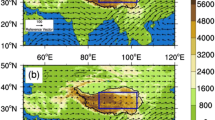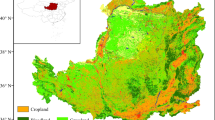Abstract
A Lagrangian approach is utilized to identify and compare the sources of water vapor transported to the four subregions of Tibetan Plateau (TP) during the wet season (May–August) of 1980–2016. We focus on the time scale and subseasonal variability of water vapor transport and the relationship between moisture supply and precipitation at the interannual scale. This study finds that: (1) The moisture sources for the four subregions differ significantly in both spatial pattern and magnitude and depend heavily on the combined effects of the summer monsoons, local recycling and the westerlies. (2) The spatial evolution of the moisture sources based on the backward trajectory analysis reveals that, although approximately 80% of the moisture is delivered to the target regions within 1–4 days, the individual subregions feature different transport pathways and associated time scales. (3) The subseasonal migration of the Indian summer monsoon regulates the importance of different moisture sources for the southern TP but not for the northern TP. Additionally, the subseasonal moisture source evolution differs greatly between the southeastern TP and the southwestern TP. (4) The interannual variability of precipitation over the whole TP during summer is negatively correlated with the variation in the moisture transported by the westerlies and is positively related to the moisture conveyed by the Indian summer monsoon for the northern TP and by adjacent moisture transport for the southern TP.













Similar content being viewed by others
References
An W, Hou S, Zhang Q, Zhang W, Wu S, Xu H, Pang H, Wang Y, Liu Y (2017) Enhanced recent local moisture recycling on the Northwestern Tibetan Plateau deduced from ice core deuterium excess records. J Geophys Res Atmos 122(23):12541–512556
Bibi S, Wang L, Li X, Zhou J, Chen D, Yao T (2018) Climatic and associated cryospheric, biospheric, and hydrological changes on the Tibetan Plateau: a review. Int J Climatol 38(S1):e1–e17
Bolch T et al (2012) The state and fate of Himalayan Glaciers. Science 336(6079):310
Bookhagen B, Burbank DW (2010) Toward a complete Himalayan hydrological budget: spatiotemporal distribution of snowmelt and rainfall and their impact on river discharge. J Geophys Res 115:F03019. https://doi.org/10.1029/2009JF001426
Bothe O, Fraedrich K, Zhu XH (2012) Tibetan Plateau summer precipitation: covariability with circulation indices. Theor Appl Climatol 108:293–300
Chen B, Xu XD (2016) Spatiotemporal structure of the moisture sources feeding heavy precipitation events over the Sichuan Basin. Int J Climatol 36(10):3446–3457
Chen B, Xu XD, Yang S, Zhang W (2012) On the origin and destination of atmospheric moisture and air mass over the Tibetan Plateau. Theor Appl Climatol 110(3):423–435
Chen B, Xu XD, Zhao T (2018) Quantifying oceanic moisture exports to mainland China in association with summer precipitation. Clim Dyn 51(11):4271–4286
Curio J, Maussion F, Scherer D (2015) A 12-year high-resolution climatology of atmospheric water transport over the Tibetan Plateau. Earth Syst Dyn 6(1):109–124
Dee DP et al (2011) The ERA-Interim reanalysis: configuration and performance of the data assimilation system. Q J R Meteorol Soc 137(656):553–597
Ding Y (1992) Summer monsoon rainfalls in China. J Meteorol Soc Jpn 70(1B):373–396
Dong W et al (2016) Summer rainfall over the southwestern Tibetan Plateau controlled by deep convection over the Indian subcontinent. Nat Commun 7:10925
Drumond A, Nieto R, Gimeno L, Ambrizzi T (2008) A Lagrangian identification of major sources of moisture over Central Brazil and La Plata Basin. J Geophys Res Atmos 113(D14):D14128
Feng L, Zhou T (2012) Water vapor transport for summer precipitation over the Tibetan Plateau: multidata set analysis. J Geophys Res Atmos 117(D20):D20114
Gao Y, Cuo L, Zhang Y (2014) Changes in moisture flux over the Tibetan Plateau during 1979–2011 and possible mechanisms. J Clim 27(5):1876–1893
Gimeno L, Drumond A, Nieto R, Trigo RM, Stohl A (2010a) On the origin of continental precipitation. Geophys Res Lett 37:L13804. https://doi.org/10.1029/2010GL043712
Gimeno L, Nieto R, Trigo RM, Vicente-Serrano SM, Lopez-Moreno JI (2010b) Where does the Iberian Peninsula moisture come from? An Answer Based on a Lagrangian Approach. J Hydrometeorol 11(2):421–436
Gimeno L, Stohl A, Trigo RM, Dominguez F, Yoshimura K, Yu L, Drumond A, Durán-Quesada AM, Nieto R (2012) Oceanic and terrestrial sources of continental precipitation. Rev Geophys. https://doi.org/10.1029/2012rg000389
Guo L, Klingaman NP, Demory M-E, Vidale PL, Turner AG, Stephan CC (2018) The contributions of local and remote atmospheric moisture fluxes to East Asian precipitation and its variability. Clim Dyn 51(11):4139–4156
Immerzeel WW, van Beek LPH, Bierkens MFP (2010) Climate change will affect the Asian water towers. Science 328(5984):1382–1385
Li M, Babel W, Tanaka K, Foken T (2013) Note on the application of planar-fit rotation for non-omnidirectional sonic anemometers. Atmos Meas Tech 6(2):221–229
Ma Y, Yao T, Wang J (2006) Experimental study of energy and water cycle in Tibetan Plateau—the progress introduction on the study of GAME/Tibet and CAMP/Tibet. Plateau Meteorol 25(2):344–351
Ma Y, Lu M, Chen H, Pan M, Hong Y (2018) Atmospheric moisture transport versus precipitation across the Tibetan Plateau: a mini-review and current challenges. Atmos Res 209:50–58
Maussion F, Scherer D, Mölg T, Collier E, Curio J, Finkelnburg R (2014) Precipitation seasonality and variability over the Tibetan Plateau as resolved by the high Asia reanalysis. J Clim 27(5):1910–1927
Nieto R, Duran-Quesada AM, Gimeno L (2010) Major sources of moisture for Antarctic ice-core sites identified through a Lagrangian approach. Clim Res 41(1):45–49
Numaguti A (1999) Origin and recycling processes of precipitating water over the Eurasian continent: experiments using an atmospheric general circulation model. J Geophys Res Atmos 104(D2):1957–1972
Pan C, Zhu B, Gao J, Kang H, Zhu T (2019) Quantitative identification of moisture sources over the Tibetan Plateau and the relationship between thermal forcing and moisture transport. Clim Dyn 52(1):181–196
Pathak A, Ghosh S, Martinez JA, Dominguez F, Kumar P (2017) Role of oceanic and land moisture sources and transport in the seasonal and interannual variability of summer monsoon in India. J Clim 30(5):1839–1859
Sodemann H, Schwierz C, Wernli H (2008) Interannual variability of Greenland winter precipitation sources: Lagrangian moisture diagnostic and North Atlantic Oscillation influence. J Geophys Res Atmos 113(D3):D03107
Stohl A, James P (2004) A Lagrangian analysis of the atmospheric branch of the global water cycle. Part I: method description, validation, and demonstration for the August 2002 flooding in Central Europe. J Hydrometeorol 5(4):656–678
Stohl A, James P (2005) A Lagrangian analysis of the atmospheric branch of the global water cycle. Part II: moisture transports between earth’s ocean basins and river catchments. J Hydrometeorol 6(6):961–984
Sun B, Wang H (2014) Moisture sources of semiarid grassland in China using the Lagrangian particle model FLEXPART. J Clim 27(6):2457–2474
Wang Z, Duan A, Yang S, Ullah K (2017) Atmospheric moisture budget and its regulation on the variability of summer precipitation over the Tibetan Plateau. J Geophys Res Atmos 122(2):614–630
Wang X, Pang G, Yang M (2018) Precipitation over the Tibetan Plateau during recent decades: a review based on observations and simulations. Int J Climatol 38(3):1116–1131
Wei W, Zhang R, Wen M, Yang S (2017) Relationship between the Asian Westerly Jet Stream and summer rainfall over Central Asia and North China: roles of the Indian Monsoon and the South Asian High. J Clim 30(2):537–552
Worden J et al (2007) Importance of rain evaporation and continental convection in the tropical water cycle. Nature 445:528
Wu G, Liu Y, Zhang Q, Duan A, Wang T, Wan R, Liu X, Li W, Wang Z, Liang X (2007) The influence of mechanical and thermal forcing by the Tibetan Plateau on Asian Climate. J Hydrometeorol 8(4):770–789
Xu X, Lu C, Shi X, Gao S (2008) World water tower: an atmospheric perspective. Geophys Res Lett 35:L20815. https://doi.org/10.1029/2008GL035867
Xu X, Zhao T, Lu C, Guo Y, Chen B, Liu R, Li Y, Shi X (2014) An important mechanism sustaining the atmospheric “water tower” over the Tibetan Plateau. Atmos Chem Phys 14(20):11287–11295
Yang K, Wu H, Qin J, Lin C, Tang W, Chen Y (2014) Recent climate changes over the Tibetan Plateau and their impacts on energy and water cycle: a review. Glob Planet Chang 112:79–91
Yao T et al (2013) A review of climatic controls on δ18O in precipitation over the Tibetan Plateau: observations and simulations. Rev Geophys 51(4):525–548
Zhang C, Tang Q, Chen D (2017) Recent changes in the moisture source of precipitation over the Tibetan Plateau. J Clim 30(5):1807–1819
Zhang C, Tang Q, Chen D, van der Ent RJ, Liu X, Li W, Haile GG (2019) Moisture source changes contributed to different precipitation changes over the northern and southern Tibetan Plateau. J Hydrometeor 20:217–229
Zhong L, Ma Y, Hu Z, Fu Y, Hu Y, Wang X, Cheng M, Ge N (2019) Estimation of hourly land surface heat fluxes over the Tibetan Plateau by the combined use of geostationary and polar-orbiting satellites. Atmos Chem Phys 19(8):5529–5541
Zhou T-J, Yu R-C (2005) Atmospheric water vapor transport associated with typical anomalous summer rainfall patterns in China. J Geophys Res 110:D08104. https://doi.org/10.1029/2004JD005413
Acknowledgements
We thank the two anonymous reviewers for insightful comments. This research is jointly supported by the National Natural Science Foundation of China (Grant No. 91637102 and 41475036) and the National Key Research and Development Program on Monitoring, Early Warning and Prevention of Major Natural Disaster (2018YFC1506001). The observed precipitation compiled by the China Meteorological Administration is available at http://data.cma.cn/. The ERA-Interim dataset can be obtained from http://www.ecmwf1.int.
Author information
Authors and Affiliations
Corresponding author
Additional information
Publisher's Note
Springer Nature remains neutral with regard to jurisdictional claims in published maps and institutional affiliations.
Electronic supplementary material
Below is the link to the electronic supplementary material.
Rights and permissions
About this article
Cite this article
Chen, B., Zhang, W., Yang, S. et al. Identifying and contrasting the sources of the water vapor reaching the subregions of the Tibetan Plateau during the wet season. Clim Dyn 53, 6891–6907 (2019). https://doi.org/10.1007/s00382-019-04963-2
Received:
Accepted:
Published:
Issue Date:
DOI: https://doi.org/10.1007/s00382-019-04963-2




